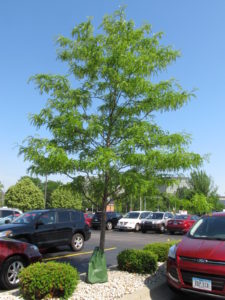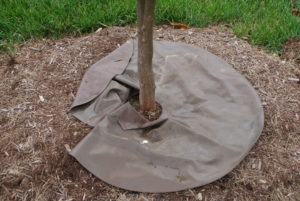Proper watering of a newly planted tree or shrub starts the day it is planted. This is the final crucial step! Dig a wide shallow hole that will accommodate the roots of the new tree. Adding soil amendments is generally not necessary unless the shrubs are moisture-loving, acidic-loving types such as azaleas (Rhododendron spp.), blueberries (Vaccinium spp.) or mountain laurels (Kalmia spp.). Treat the original topsoil removed from the hole as “gold” as it contains some humus.
Water deeply after planting. For a 3-4 feet wide hole, add a minimum of 5 gallons of water. Add 2-3 inches of organic mulch such as shredded pine bark, pine straw (needles) or lawn grass clippings.
Under- or over-watering may kill the tree. Too much water drowns tree roots; it takes oxygen out of the soil around the roots. Yellowing or sudden leaf loss are common symptoms of overwatering, usually first noticed on the interior leaves.
Most tree roots grow in the top 6 to 12 inches below the soil surface. To water a newly transplanted tree, you might opt to using a soil needle, aka “root feeder” which is attached to a garden hose. Water goes deeply to the root zone. A root feeder is a valuable tool for watering older trees and shrubs as well.
Water newly transplanted trees thoroughly through September (in most states), then gradually cut back watering in autumn to allow plants to “harden off” as cold weather sets in. After the leaves drop, continue watering if natural moisture is significantly below average.
Newly planted trees and shrubs need adequate soil moisture to become established, especially through the first hot dry summer. Naturally shallow rooted trees such as Japanese maples (Acer palmatum), spruces (Picea spp.) and azaleas require more frequent watering than tap rooted species such as oaks, ashes and walnuts.
Drip irrigation system or soaker hose is common methods of timely supplying water. Treegator™ bags, available in 15 and 20 gallon sizes, slowly release water (and nutrients) to a newly planted tree. They’re available through garden centers, hardware and box stores across the U.S.
Additional facts:
- Newly planted trees need more frequent watering than those established 3 years or more. Larger trees demand more soil moisture than smaller species.
- Evergreens do require watering during the fall-winter period in areas with a rainfall deficit.
- Clay and silt loams retain more soil moisture than porous sandy soils.
- Weekly rainfall amounts of one inch per week during the growing season is rated satisfactory.



 Posted in
Posted in 
